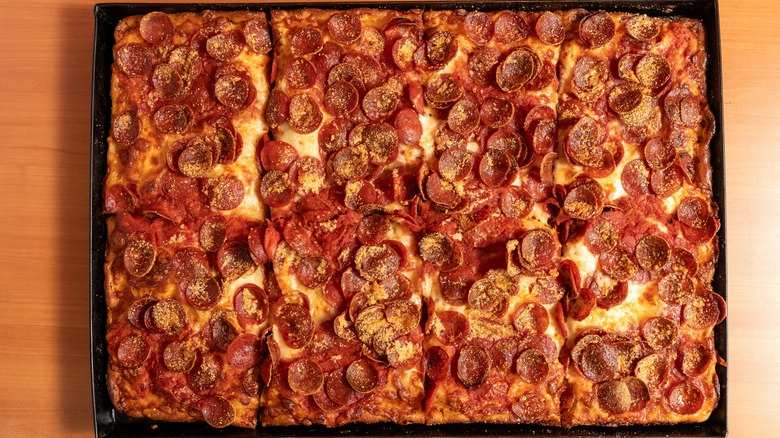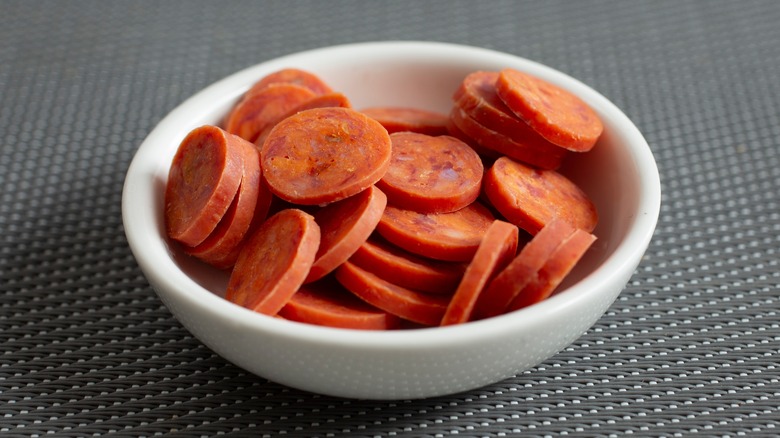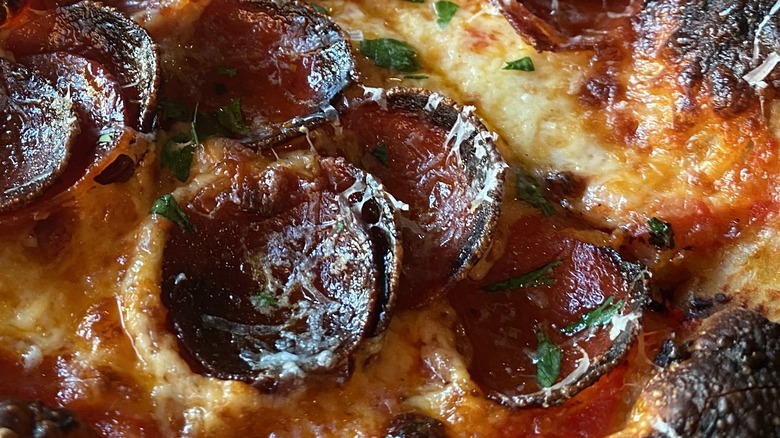What Sets Old World Pepperoni Apart From The Rest
Pepperoni is consistently ranked as the most popular pizza topping, and it's hard to imagine that anything else could come close. Now, all you pizza lovers may think you know all there is to know about pepperoni, but few really understand just how diverse the pepperoni world is. There are numerous distinct styles of pepperoni. Of course, you have the typical pepperonis found on most chain pizzas, which are flat, and about the size of a half-dollar coin. Sometimes, you'll see huge circles of deli pepperoni, a common choice for sandwiches. But the true cream of the crop, the once and future king of the pepperoni kingdom, is Old World pepperoni.
Old World pepperoni refers to the type of pepperoni that cups up when you cook it, allowing the edges to get just a little bit charred and crisp. It is typically spicier than your standard, flat pepperoni, and when it cups, you get a little pool of chili-infused oil in the center. It brings more flavor and texture to pizza than other types of pepperoni. It is commonly associated with Detroit-style pizza, but it is an asset to almost any type of pie (except deep dish, where the cupping power would be lost). The key to Old World pepperoni's cupping magic lies in its casing.
Old World pepperoni is made with a natural casing
The difference between Old World pepperoni and other styles lies in the types of sausage casings they use. Most types of pepperoni are stuffed into a synthetic casing, made of cellulose or plastic. Neither of these substances are edible, of course, so the casings are removed before the pepperoni is sliced and served. Old World pepperoni, on the other hand, is stuffed into a natural casing. Natural casings are made from submucosa, a layer of collagen that is part of animal intestines. Sheep, cows, pigs, and goats may all be used for natural casings.
Unlike synthetic casings, natural casings don't need to be removed before you eat the pepperoni. This means that each slice of Old World pepperoni is surrounded by a ring of natural casing. Most people believe that the ring of casing is what makes Old World pepperoni cup, and that's sort of true, but there's more to it than that. J. Kenji López-Alt of Serious Eats discovered that the real reason natural casings make pepperoni cups is because they don't stretch like synthetic casings do. Consequently, when the sausage is stuffed, the meat gets packed into an awkward "U" shape, the same shape you'd see if you cut a slice of cupped pepperoni in half. So, the way the meat is stuffed into the casing gives it a cupped shape, and you can actually get the same cupping result if you remove the casing from Old World pepperoni.
Old World is not an accurate name
You might be wondering how Old World pepperoni got its name. As you'll remember from history class, "Old World" refers to the eastern hemisphere, while "New World" refers to the western hemisphere, i.e. the Americas. The "Old World" in Old World pepperoni refers to pizza's homeland of Italy, juxtaposing it with the flat pepperoni of the New World. But there's a problem with this name. Old World pepperoni wasn't invented in Italy. It was invented in the New World.
This may come as a shock, but there's actually no such thing as pepperoni in Italy. There are similar types of cured sausages, like soppressata, but nothing that's actually called "pepperoni." The truth is, pizza's best buddy originated in New York in the early 1900s. It was invented by Italian immigrants who could no longer access all the ingredients of their homeland and had to reimagine foods, like sausages, using New World ingredients. One of those ingredients was paprika, which gives pepperoni its dark red hue. Paprika is made from bell pepper, which is known in Italy as "peperone." In this sense, all pepperoni is actually New World pepperoni, but the Old World variety gets its name because it uses natural casings, just like those old traditional sausages of Italy.


